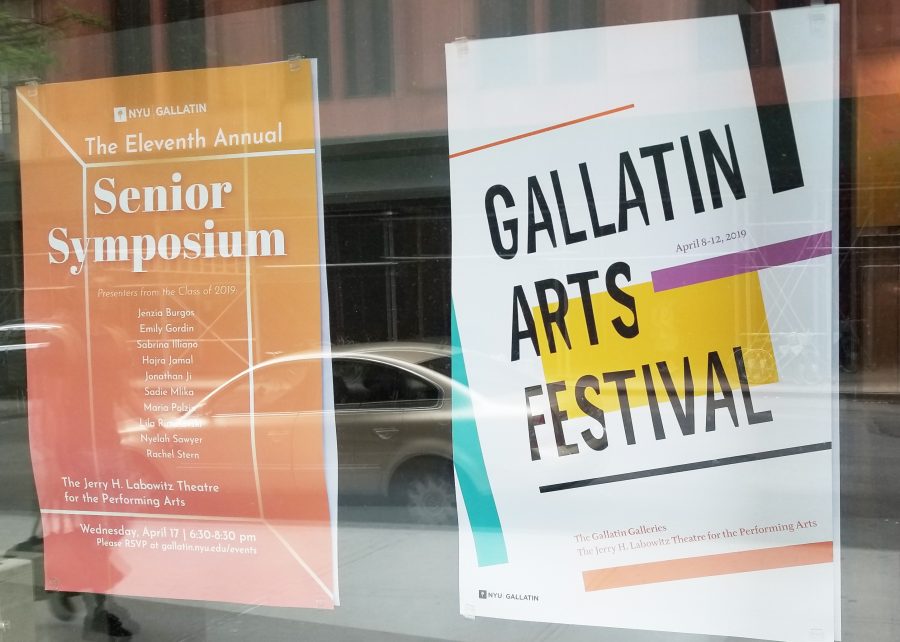The 26th annual Gallatin Arts Festival, a weeklong showcase of artwork and performances by students in the Gallatin School of Individualized Study, kicks off tonight with a gallery opening, an evening of performances and wine and hors d’oeuvres.
A team of more than a dozen undergraduates, two faculty members, a graduate student and a smattering of building staff and administrators collaborated to assemble GAF over months of assessing submissions, organizing and workshopping performances, installing pieces, social media outreach and more.
“This festival, especially this year’s content, is trying to challenge the norm of festivals and performance and audience experience,” said Artistic Director Kristin Horton, a theater director and Gallatin professor.
The work the curators and producers select often grapples with apparently disparate academic fields. “I think it’s very reflective of the Gallatin community where everything is so interdisciplinary and people don’t engage in just one practice or one theme,” said Andrea Meyer, a curator and Gallatin senior.
One example the curators cited is Mamoun Nukumanu’s work “Polyzome,” which includes a microbial culture housed in a hand-blown glass container.
“It’s like the cross-section between fine art and biology,” said Emily Cunningham, a curator and Gallatin senior.
“And it’s executed so well,” said fellow curator Laura Rendon, a Gallatin first-year. “[Nukumanu] really knows what he’s doing,” she said.
Operating within Gallatin’s signature framework of independent, student-led academic inquiry, GAF is put together mostly by a team of Gallatin students, led by Festival Manager Cheyenne Myrie, a second-year graduate student in the school.
“Kristin and I have a very similar philosophy that it is the students’ festival,” said Visual Arts Advisor Keith Miller, who also serves as the director of the Gallatin Galleries and as a member of the Gallatin faculty. He and Horton give the producers and curators general guidance, but their approach is relatively hands-off.
Starting at the beginning of the spring semester, two groups of undergraduates — a team of curators and a team of producers — evaluate submissions over several months; they make decisions about which works to accept and then about how to present the accepted work.
“We looked for innovative ways of being interdisciplinary, and asked the question, ‘Why is this piece important to show in the here and now, and how does it connect to the world at large?’” said producer Cheryle Chong, a Gallatin senior.
Generally speaking, the curators — guided by Miller — work with the visual arts pieces, which will be on display in the Gallatin Galleries, while the producers — guided by Horton — focus on performance-based work that will be shown in the Jerry H. Labowitz Theatre for the Performing Arts.
The curators’ job is relatively straightforward — they work together to figure out how best to display work within the Gallatin Galleries’ space. The producers’ responsibilities are less strictly defined.
“In the initial stages, it’s a lot about like envisioning what the sort of long-term plan is, what the timeline is,” producer and Gallatin sophomore Mouli Ghosh said. “Then as we get closer to tech [week], it’s a lot of logistical sorts of things.”
“[Producers] also serve as an outside eye, and reflect back on the audience experience,” Horton said.
In classic Gallatin fashion, many of the pieces to be shown straddle the line between performance and visual art. Pieces that fall under the umbrella term “performance art” are generally within the curators’ purview, and are presented in the gallery space.
The first GAF was held in 1992, spearheaded by Gallatin professor Laurin Raiken and graduate student Barry Spanier before Gallatin had its own building. When Miller first became involved with the festival in 2007, it was still being held in whatever spaces around the city GAF could find.
“I think that our ambitions have gotten bigger [since 2007],” Miller said. “Originally it felt maybe a little bit more like a college student show, and now it starts to feel more and more like a show,” he said.
Today, the festival occupies a unique place within both Gallatin and NYU as a whole.
“There aren’t a lot of avenues for fine art especially, so this is just a really good opportunity for artistic Gallatin students to show their work,” Cunningham said.
“A lot of these works are emerging from the scholarship that we’re engaged with here at Gallatin, but also expanding beyond that,” said Ellie New, a producer and junior in the school. “We’re a venue and an opportunity in which artists can try new forms or new mediums and look at how to engage their artistic practice with what they’re doing here at school, and also work outside of their comfort zone.”
But GAF is also a moment for the Gallatin community, defined by its students’ independence and self-directed academic inquiry, to come together.
“This is a community festival that really emphasizes community-building,” Horton said.
The Gallatin Arts Festival runs April 8 to 12 in the Gallatin Galleries and the Jerry H. Labowitz Theatre for the Performing Arts, both in the Gallatin building at 1 Washington Place. A full list of artists and a schedule of performances can be found here.
A version of this article appeared in the Monday, April 8, 2019, print edition. Email Alex Cullina at [email protected].


























































































































































